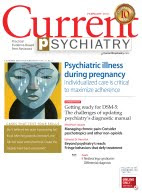Friday, May 1, 2009
Economic anxiety: First aid for the recession’s casualties
Christopher Palmer, MD
Medical director, Continuing medical education, McLean Hospital, Belmont, MA, Harvard Medical School
Jeffrey Rediger, MD, MDiv
Medical director, Adult inpatient service, McLean Hospital, Belmont, MA, Harvard Medical School
Carol Kauffman, PhD, ABPP, PCC
Director, Institute of Coaching, McLean Hospital, Belmont, MA, Harvard Medical School
How is the recession affecting psychiatric practice? Christopher Palmer, MD, says, “We in psychiatry and psychology are well-equipped to help people who are unemployed, underemployed, and financially ruined. We do it all the time. The difference in this economy is that we’re going to be seeing a lot more people.”
Psychiatrists who read Current Psychiatry and were polled in March 2009 agree. Most were seeing an increase in patients experiencing psychological stress because of the recession, which by then had persisted 16 months. “All my patients are reporting increased stress as a result of the economic situation. The more successful my patient is, the more distress they seem to be feeling,” says a psychiatrist from Melbourne, FL.
This article on the psychological effects of the recession discusses the results of an online survey of Current Psychiatry readers, with analysis and recommendations from an interview with Dr. Palmer and colleagues Jeffrey Rediger, MD, MDiv, and Carol Kauffman, PhD, ABPP, PCC, from McLean Hospital, Belmont, MA, and the department of psychiatry, Harvard Medical School.
Read full text (free access)
Comment on this article
Email the editor
Risk factors for suicide in borderline personality disorder
Michele S. Berk, PhD
Assistant professor of psychiatry, David Geffen School of Medicine at UCLA, Harbor-UCLA Medical Center, Torrance, CA
Bernadette Grosjean, MD
Assistant professor of psychiatry, David Geffen School of Medicine at UCLA, Harbor-UCLA Medical Center, Torrance, CA
Heather D. Warnick, PsyD
Postdoctoral Fellow, Harbor-UCLA Medical Center, Torrance, CA
Manipulative, “just threats,” or suicide gestures are terms you may have heard or used to label suicidal thoughts and behavior in individuals with borderline personality disorder (BPD). These terms imply that the risk of injury or death is low, but evidence shows that BPD patients are at high risk for completed suicide—and clinicians who use these labels may underestimate this risk and respond inadequately.
Based on the literature and our clinical experience, this article offers recommendations for assessing and treating suicidal behavior in BPD patients. We review risk factors for suicide and suicide attempts and suggest strategies for safety management, psychotherapy, and pharmacotherapy. Because of the high-risk nature of this population, we recommend that all clinicians working with suicidal BPD patients obtain consultation and supervision as needed when using these strategies.
Read full text (free access)
Listen to Dr. Berk discuss suicide risk in BPD
Comment on this article
Email the editor
Labels:
borderline personality disorder,
suicide
What is your patient’s predicament?
Daniel D. Cowell, MD
Senior associate dean for graduate medical education, Professor of psychiatry, Department of psychiatry and behavioral medicine, Joan C. Edwards School of Medicine, Marshall University, Huntington, WV
When a patient’s symptoms seem disproportionate to apparent stressors, I call this presentation a patient’s predicament: a unique, profoundly unsettling, but poorly understood misgiving that something is wrong—perhaps terribly so—and that life may never be the same again. Emotional flooding typically overwhelms these patients, and they are unable to express what they are experiencing.
For mental health professionals, the concept of a predicament is useful when working with patients who are moderately to severely ill or facing a life-diminishing or life-threatening illness.
Read full text (free access)
Comment on this article
Email the editor
The hallucination portrait of psychosis: Probing the voices within

Henry A. Nasrallah, MD
Editor-in-Chief
On recent hospital rounds with residents and medical students, a medical student presented a 20-year-old man with first-episode psychosis. The student mentioned that the patient admitted to hearing voices, and the admission note in the patient’s chart referred simply to “AH+” (auditory hallucinations present)
I was disappointed. This sparse description of a key psychotic symptom ignored rich details that could provide important clinical and safety information about the patient. So I suggested that the students and residents ask this patient many more questions about his AH.
In my experience, clinicians rarely retrieve and document the wealth of data available about AHs when assessing persons with psychosis. I recommend that clinicians include such details in the initial mental status exam of a patient with psychosis.
Read full text (free access)
Comment on this article
Email the editor
Subscribe to:
Posts (Atom)

